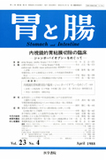Japanese
English
- 有料閲覧
- Abstract 文献概要
- 1ページ目 Look Inside
- サイト内被引用 Cited by
要旨 従来の内視鏡的ポリペクトミーは1本のスネアで有茎性病変になされていた.広基性病変や陥凹性病変の内視鏡的粘膜切除が可能であるendoscopic double snare polypectomyを考案し,隆起性異型上皮巣83病変,陥凹性異型上皮巣3病変,Ⅱa 65病変,Ⅱc 33病変の内視鏡的切除を施行した.隆起性病変2cm以下,陥凹性病変1cm以下のほとんどの症例(前者119/128=93%,後者21/21=100%)が一括切除され,他は分割切除であった.分割切除法では回収標本の再構築が難しく,完全摘除か否かの判定が曖昧となり根治を目指した本法では避けるべきである.一括切除法の遠隔成績は,初回内視鏡的切除治癒は異型上皮巣92%(67/73),Ⅱa 81.8%(45/55),Ⅱc 86.7%(26/30)であり,遺残率は異型上皮巣8.2%,Ⅱa 14.6%,Ⅱc 10%,再発率はそれぞれ0%,3.6%(2/55),3.3%(1/30)であった.遺残例の58.8%(10/17)は内視鏡的再切除で治癒し,手術施行例は断端面の粘膜下組織内癌遺残5例を含め7例(7/161=4.3%)であった.したがって最終的な内視鏡的切除治癒率は95%(153/161)と満足すべき良好な成績であり,根治療法としての有用性が確認された.再発例の回収切除標本および胃生検標本のretrospectiveな検討では挫滅組織内の癌や切り出し不足による癌の見逃し,あるいは切除後胃生検で癌を再生異型と誤診したもので,再発でなく遺残であった.遺残例の多くはⅡaでは2cm以上,Ⅱcでは分化型でも1cm以上か未分化型癌であった.したがってこれら病変は技術的な内視鏡的切除の非適応病変とすべきである.なお,本対象胃癌例の14.4%(13/90)に多発胃癌,異型上皮巣との合併を4例(4.4%)に認め,それらの13病変は内視鏡的切除で治癒した.内視鏡的切除前および切除後のfonow-upでも常に多発病変,殊に多発癌の存在に注意することが肝要である.
The indication for endoscopic double snare polypectomy (EDSP) for gastric lesions was assessed, based on 184 lesions (83 lesions of protruded atypical epithelial lesion, 3 lesions of depressed atypical epithelial lesion, 65 lesions of Ⅱa type early cancer, and 33 lesions of IIc type early cancer) which had been experienced at the Cancer Institute Hospital between March 1975 and March 1987. EDSP has made it possible to endoscopically resect broad-based and even depressed gastric lesions.
In the polypoid lesions measuring less than 2.0 cm 93% (119/128) of them were resected by single snare cautery. The remaining 7% of them EDSP resulted in piecemeal resection. In the depressed lesions measuring less than 1.0 cm 100% (21/21) were resected by single snare cautery. Piecemeal resection must be avoided in EDSP that aims at radical treatment of gastric lesions because it does not permit the reconstruction of retrieved materials, and makes the judgement of complete resection equivocal.
The curability in the first EDSP by single cautery was 92.0% (67/73) in atypical epithelial lesion (ATP), 81.0% (45/55) in Ⅱa type early gastric cancer, and 86.7% (26/30) in Ⅱc type early cancer.
The rate of the residual lesions was 7.9% (6/76) in ATP, 14.6% (8/55) in Ⅱa type early cancer, and 10.0% (3/30) in Ⅱc type early cancer. The reccurrence rate was 0% (0/26) in ATP, 3.6% (2/55) in Ⅱa type early cancer, 3.3% (1/30) in Ⅱc type early cancer. Repeat EDSP was tried for 10 cases (58.8%, 10/17) of the residual lesions, resulting in complete cure, and the surgical resection was performed for 7 cases of cancer, including 5 cases with submucosal involvement. The over-all curability of the gastric lesions by EDSP was 95.0% (153/161). This result was considered to be satisfactory, and guarantees the usefullness of EDSP as the radical treatment method of gastric lesions.
The most residual lesions were Ⅱa type early cancer measuring more than 2.0 cm and Ⅱc type early cancer measuring more than 1.0 cm or undifferentiated one. These lesions are not technically indicated for EDSP. Moreover, there were 14.4% (13/90) of multiple cancers and 4.4% (4/90) of ATP in the materials used. Thirteen lesions of them, including 9 lesions of cancer and 4 lesions of ATP were treated by EDSP. Attention should be paid to the presence of multiple cancers before EDSP and in the follow-up endoscopy.

Copyright © 1988, Igaku-Shoin Ltd. All rights reserved.


